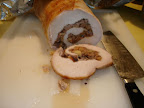Stuffed Boneless Pork Loin Roast
1 center cut boneless pork loin roast ~3.5 lb.
1 med. apple (Gala, Granny Smith), diced
1/2 cup diced onion
1 cup pecan halves, chopped
3 slices bacon, cooked crispy, diced
2-3 oz. fresh mushroom slices, chopped
3 cloves garlic, minced
1/2 t. dried rosemary, ground
1 C. breadcrumbs
1/2 C. apple sauce
3 T. butter or margarine
salt & pepper
1 C. Diamond Crystal kosher salt
10-12 ft. kitchen twine
24 hours in advance, brine pork loin roast in kosher salt dissolved in 1 gallon cold water, in a non-reactive container. Refrigerate.
Saute onion in butter until translucent. Add apple, bacon, mushroom, pecans, rosemary and cook until apple just begins to soften. Mix together apple sauce and breadcrumbs. Reduce heat to low and add garlic and breadcrumb/apple sauce mixture, combining thoroughly with other ingredients. Remove stuffing to bowl, and place in freezer or refrigerator to cool to refrigerator temp.
Remove pork loin from brine, rinse and pat dry. Place roast on cutting board fat cap down, noting which side is the more tapered. Orient roast so the tapered side is toward your cutting hand. Using sharp knife, cut lengthwise along the roast with knife blade held flat about 3/4″ above the cutting board. Carefully continue to cut, “unrolling” roast as you go, so that you end up with a mostly flat, rectangular piece of meat about 3/4″ thick overall. Thicker parts may be flattened with a meat mallet. Salt& pepper both sides of meat. If stuffing mix is not yet cold, roll up and return meat to refrigerator until time to continue.
Pre-heat oven to 325°.
Unroll meat onto cutting board and spread stuffing mixture evenly, leaving about a 1/2″ border all around, a little more like 1.5″ on the edge that was originally inner most part of roast. Roll up, being careful not to apply too much pressure and force stuffing out. Stuffed roast should end up fat cap up, and seam side down.
Using butcher’s twine, truss roast at about 1″ intervals. Run excess twine down and back through bottom of each loop, then up to knot at top of first loop, and secure. This sounds harder than it is, but once you do it, it’s quite simple.
Place roast in large pre-heated skillet, and sear on all sides. Place roast seam side down on rack in roasting pan, and cook until meat thermometer reads 140° in center of roast, about 75 minutes. Remove from oven and rest, covered loosely with sheet of foil. Residual heat will continue to cook, and internal temperature should rise to 145-148. This temperature range is considered completely and safely cooked for today’s pork products.
Photo of final product below.
My original intent was to smoke roast on the smoker using apple and pecan woods for smoke flavor. When I went out to light the charcoal, it started to drizzle, and I just wasn’t in the mood to get wet, since my smoker umbrella was ruined in Gustav. I also ended up making french fries out of butternut squash instead of the roasted root vegetables I had originally planned.
This stuffing represents only one of many possible combinations one might use. Part of it was planned (apple, onion, pecan, breadcrumbs); part was just stuff I happened to have on hand (mushrooms, bacon, garlic, apple sauce).
